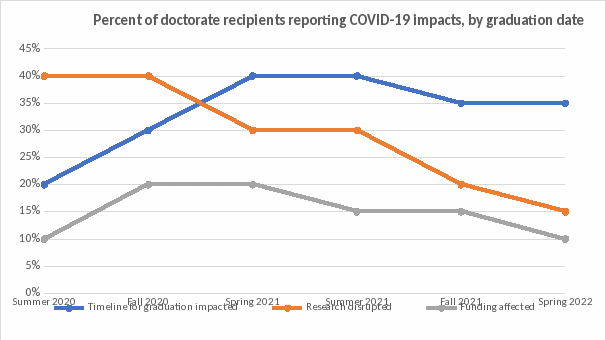Analysis Plan for SED COVID-19 Data Items
Attachment 3 Analysis Plan for SED COVID19 Data 6.9.2020.docx
Survey of Earned Doctorates
Analysis Plan for SED COVID-19 Data Items
OMB: 3145-0019
Attachment 3. Analysis Plan for SED COVID-19 Data Items
The novel coronavirus pandemic has disrupted many aspects of higher education and the training of the next generation of the scientific and technical workforce. Graduate students may encounter multiple challenges along the path to the doctorate that are directly attributable to the effects of the pandemic.
Among the most salient obstacles facing doctorate students:
campus closures
disruption of research lab activities including:
lack of physical access to research equipment or data
destruction of research specimens
inability to travel to conduct field research
loss of financial support for graduate studies (research fellowships/grants, teaching assistantships, part-time employment outside universities)
disruption in labor markets and constriction of job opportunities
The degree to which these challenges affect research doctorates’ training and initial career pathways can be measured with the addition of a question module to the 2021 Survey of Earned Doctorates. The goal with these questions is to present a parsimonious set of items designed to maximize NCSES’s ability to differentiate the impact of the pandemic on graduate training and career pathways while minimizing additional response burden.
Research Questions
Among the research questions these items are designed to address:
Has the coronavirus pandemic affected time to degree for research doctoral graduates?
Has the pandemic disrupted research activities of doctoral graduates?
Have doctoral graduates experienced a loss of financial support related to budgetary impact of the pandemic?
Have doctoral graduates changed their immediate postgraduate plans as a result of the pandemic?
Did the pandemic cause doctoral graduates to alter their career plans or goals in terms of research specialization or employment sector?
Did the pandemic have an effect on the geographic mobility of doctorates? Are the doctoral graduates on temporary visa more or less likely to prefer to remain in the U.S.?
Additional avenues of inquiry for these questions is whether the impacts felt by research doctorates are differentiated by field of study, sex, race/ethnicity, or citizenship?
Data Release
The first round of data will be released with the 2021 SED data, in November 2022. Results could be included in the rotating theme for the SED Digest or as a separate InfoBrief.
Below are some of the tables that could be constructed and released as an InfoBrief or as the rotating them for the 2021 SED Digest.
Table 1: Reports all COVID-19 impacts indicated by respondents by broad field, sex, marital status, race, and citizenship status
This table would present the overall impacts experienced by various respondents and allow comparisons of experiences by the above demographic variables
Table 2: Reports median years to doctorate by COVID-19 impact, sex, citizenship status, ethnicity, race, and broad field of study.
This table would allow researchers to compare the impact of COVID-19 on time to degree for various demographic groups in each broad field of study.
Table 3: Reports employment sector for doctorate recipients with definite postgraduation commitments by COVID-19 impact, and broad field of study.
We would list all doctorates, those reporting COVID-19 impact, and those not reporting COVID-19 impact.
We can include 2019 and 2020 data as baseline for pre-pandemic comparisons.
Table 4: Reports doctorate recipients with temporary visas intending to stay in U.S. after degree conferral by COVID-19 impact and continent
If there are sufficient responses, we can disaggregate by country of citizenship (e.g. China, Korea, India, etc.)
We can include data from 2016-2020 as baselines for pre-pandemic comparisons
Table 5: Reports post-graduation location by COVID-19 impact and broad field of study
We can include 2019 and 2020 data as baseline for pre-pandemic comparisons.
We can create a new derived variable: location same as institution. We would match the region of the institution to the region of postgraduation location
We can also create a similar variable for location of high school (item C9 of the 2019 SED)
We can also analyze the impact for each graduating cohort, beginning with the people graduating in Summer 2020, Fall 2020, and Spring 2021. If we continue the questions for the 2022 SED and beyond, we may be able to chart when the impacts peak and when they begin to lessen; the recovery rates for each type of impact may be different. A hypothetical example is shown below.

| File Type | application/vnd.openxmlformats-officedocument.wordprocessingml.document |
| Author | Green, Patricia |
| File Modified | 0000-00-00 |
| File Created | 2023-09-02 |
© 2026 OMB.report | Privacy Policy